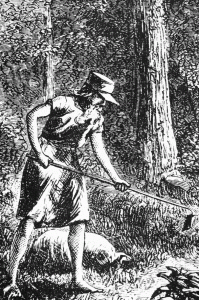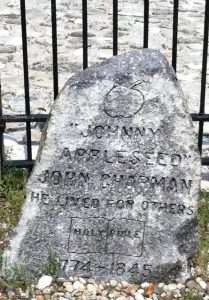 On September 26, 1774, a man named John Chapman, who is my 6th cousin 6 times removed, was born in Leominster, Massachusetts. John was the second child, after his sister Elizabeth, of Nathaniel and Elizabeth Chapman. While Nathaniel was in military service, his wife died on July 18, 1776, shortly after giving birth to a second son, Nathaniel. The baby died about two weeks after his mother. Nathaniel Chapman ended his military service and returned home in 1780 to Longmeadow, Massachusetts. In the summer of 1780 he married Lucy Cooley of Longmeadow, Massachusetts, and they had 10 children. So in the end, John Chapman came from a large family. You might wonder what all this has to do with anything, and I suppose you would be justified in asking, but I think when you hear John Chapman’s nickname, you might know who I am talking about. For most of his life, John Chapman was called, Johnny Appleseed. Most people will remember him from the history books, as an American pioneer nurseryman who introduced apple trees to large parts of Pennsylvania, Ontario, Ohio, Indiana, and Illinois, as well as the northern counties of present-day West Virginia. He became an American legend while he was still alive, due to his kind, generous ways, his leadership in conservation, and the symbolic importance he attributed to apples. These days plant nurseries are often named after Johnny Appleseed, including on in my city of Casper, Wyoming.
On September 26, 1774, a man named John Chapman, who is my 6th cousin 6 times removed, was born in Leominster, Massachusetts. John was the second child, after his sister Elizabeth, of Nathaniel and Elizabeth Chapman. While Nathaniel was in military service, his wife died on July 18, 1776, shortly after giving birth to a second son, Nathaniel. The baby died about two weeks after his mother. Nathaniel Chapman ended his military service and returned home in 1780 to Longmeadow, Massachusetts. In the summer of 1780 he married Lucy Cooley of Longmeadow, Massachusetts, and they had 10 children. So in the end, John Chapman came from a large family. You might wonder what all this has to do with anything, and I suppose you would be justified in asking, but I think when you hear John Chapman’s nickname, you might know who I am talking about. For most of his life, John Chapman was called, Johnny Appleseed. Most people will remember him from the history books, as an American pioneer nurseryman who introduced apple trees to large parts of Pennsylvania, Ontario, Ohio, Indiana, and Illinois, as well as the northern counties of present-day West Virginia. He became an American legend while he was still alive, due to his kind, generous ways, his leadership in conservation, and the symbolic importance he attributed to apples. These days plant nurseries are often named after Johnny Appleseed, including on in my city of Casper, Wyoming.
According to some accounts, an 18 year old John persuaded his 11 year old half-brother Nathaniel to go west with him in 1792. The boys lived a nomadic life until their father brought his large family west in 1805 and met  up with them in Ohio. Nathaniel decided to stay and help their father farm the land. A short time later, John began his apprenticeship as an orchardist under a Mr. Crawford, who had apple orchards, and so began his life’s journey of planting apple trees. There are stories of Johnny Appleseed practicing his nurseryman craft in the area of Wilkes-Barre, Pennsylvania, and of picking seeds from the pomace at Potomac cider mills in the late 1790s. Another story has Chapman living in Pittsburgh on Grant’s Hill in 1794 at the time of the Whiskey Rebellion.
up with them in Ohio. Nathaniel decided to stay and help their father farm the land. A short time later, John began his apprenticeship as an orchardist under a Mr. Crawford, who had apple orchards, and so began his life’s journey of planting apple trees. There are stories of Johnny Appleseed practicing his nurseryman craft in the area of Wilkes-Barre, Pennsylvania, and of picking seeds from the pomace at Potomac cider mills in the late 1790s. Another story has Chapman living in Pittsburgh on Grant’s Hill in 1794 at the time of the Whiskey Rebellion.
The most popular image is of Johnny Appleseed spreading apple seeds randomly everywhere he went. In reality, he planted nurseries rather than orchards, and then built fences around them to protect them from livestock. Then he left the nurseries in the care of a neighbor who sold trees on shares, and returned every year or two to tend the nursery. His first nursery was planted on the bank of Brokenstraw Creek, south of Warren, Pennsylvania. Next, he seems to have moved to Venango County along the shore of French Creek, but many of his nurseries were in the Mohican area of north-central Ohio. This area included the towns of Mansfield, Lisbon, Lucas, Perrysville, and Loudonville.
Johnny Appleseed was a bit of a missionary too. He would tell stories to children and spread The New Church gospel to the adults, receiving a floor to sleep on for the night, and sometimes supper, in return. “We can hear him read now, just as he did that summer day, when we were busy quilting upstairs, and he lay near the door,  his voice rising denunciatory and thrillin—strong and loud as the roar of wind and waves, then soft and soothing as the balmy airs that quivered the morning-glory leaves about his gray beard. His was a strange eloquence at times, and he was undoubtedly a man of genius,” reported a lady who knew him in his later years. He made several trips back east, both to visit his sister and to replenish his supply of Swedenborgian literature. Swedenborgian was also known as Swedenborgianism and the General Church of the New Jerusalem. Several historically related Christian denominations were developed as a new religious movement, by the writings of Emanuel Swedenborg. Johnny preached the gospel as he traveled, and converted many Native Americans. The Native Americans regarded him as someone who had been touched by the Great Spirit, and even hostile tribes left him strictly alone. Johnny passed away about 1845, with several dates being given. I guess no one really knew the date for sure. I think my cousin might have been a very interesting man.
his voice rising denunciatory and thrillin—strong and loud as the roar of wind and waves, then soft and soothing as the balmy airs that quivered the morning-glory leaves about his gray beard. His was a strange eloquence at times, and he was undoubtedly a man of genius,” reported a lady who knew him in his later years. He made several trips back east, both to visit his sister and to replenish his supply of Swedenborgian literature. Swedenborgian was also known as Swedenborgianism and the General Church of the New Jerusalem. Several historically related Christian denominations were developed as a new religious movement, by the writings of Emanuel Swedenborg. Johnny preached the gospel as he traveled, and converted many Native Americans. The Native Americans regarded him as someone who had been touched by the Great Spirit, and even hostile tribes left him strictly alone. Johnny passed away about 1845, with several dates being given. I guess no one really knew the date for sure. I think my cousin might have been a very interesting man.


Leave a Reply